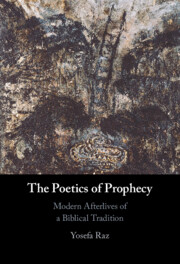Book contents
- The Poetics of Prophecy
- The Poetics of Prophecy
- Copyright page
- Dedication
- Contents
- Illustrations
- Acknowledgements
- Introduction
- Chapter 1 Seraphic Choirs and Stuttering Prophets: Symmetry, Disorder, and the Invention of the Literary Bible
- Chapter 2 Walking through William Blake’s Irregular Bible
- Chapter 3 The Myth of Primordial Orality and the Disfigured Face of Written Prophecy
- Chapter 4 Ahad Ha’am’s Mask of Moses and the Secularization of Prophetic Power
- Chapter 5 Haim Nahman Bialik: The National Poet’s Cup of Sorrows
- Afterword
- Bibliography
- Index
- Index of Biblical Quotes
- References
Bibliography
Published online by Cambridge University Press: 14 December 2023
- The Poetics of Prophecy
- The Poetics of Prophecy
- Copyright page
- Dedication
- Contents
- Illustrations
- Acknowledgements
- Introduction
- Chapter 1 Seraphic Choirs and Stuttering Prophets: Symmetry, Disorder, and the Invention of the Literary Bible
- Chapter 2 Walking through William Blake’s Irregular Bible
- Chapter 3 The Myth of Primordial Orality and the Disfigured Face of Written Prophecy
- Chapter 4 Ahad Ha’am’s Mask of Moses and the Secularization of Prophetic Power
- Chapter 5 Haim Nahman Bialik: The National Poet’s Cup of Sorrows
- Afterword
- Bibliography
- Index
- Index of Biblical Quotes
- References
- Type
- Chapter
- Information
- The Poetics of ProphecyModern Afterlives of a Biblical Tradition, pp. 192 - 206Publisher: Cambridge University PressPrint publication year: 2023



